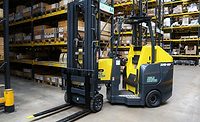AmBev Central America
BY ENRIQUE SAEZ
Revolutionizing the Central American beer market
There are few business
activities that have created as much enthusiasm in Latin America as the
expansion of AmBev. Creating the world’s largest brewing company by
volume, Brazil’s AmBev merged with
Belgium’s Interbrew in 2004. In Latin America, the company has
successfully introduced its brewery formula in Peru, the Dominican Republic, Argentina and Guatemala. Beverage Industry sister publication Industria Alimenticia recently
visited Cabcorp, the Central American subsidiary of the group, in Guatemala
and shared this report.
The history of AmBev in Guatemala began in 2002, when
it reached an agreement with Cabcorp to develop a new company in which each
business would have a 50 percent responsibility. “Each contributed
their strength, AmBev with all its knowledge of the beer market and Cabcorp
with its knowledge of the local market and distribution in five countries
in the region,” Cabcorp’s Marcelo Pera explains.
Cabcorp is an anchor bottler for PepsiCo for the
region, and wanted to expand into the beer market. The agreement came
together quickly due to AmBev’s confidence in associating itself with
the principal bottler in one of the countries in which Pepsi-Cola is the
market leader.
Pera says the Guatemalan press provided extensive
coverage of AmBev’s plant opening in Guatemala, and the launch of its
Brahma beer brand, or Brahva as it is known there, in September 2003 was so
successful it created more demand than the company anticipated. It was
temporarily forced to go into select distribution until it could satisfy
all of the demand.
“We came out very well, and in February 2004 we
obtained national coverage,” Pera recalls. The company achieved 30
percent market share with the launch, he says.
The next logical step was the expansion of the brand
in the rest of the Central American markets. The company launched the
product in Nicaragua in June 2004, and in El Salvador in February 2005.
Future expansion in the region is planned for
Honduras, Costa Rica and Panama.
Futuristic plant
Without a doubt, a major consideration when a brewing
company locates in a specific place is the quality of the water. Guatemala
provided both good quality in terms of natural mineral content and quantity
of water. The company decided to locate the factory three hours from
Guatemala City and five hours from San Pedro Sula for its proximity to the
rest of the region.
The plant is located close to the east and northeast
area of the country, the hottest zone and with the highest rent per capita.
For this, it made an original investment of $50 million, and added $10
million during the first year.
One of the principle challenges AmBev had to overcome
in its partnership with Cabcorp was the education of operators whose
previous experience was in the area of soft drinks. In order to have a
totally new plant it contracted operators without training, and the first
group of line supervisors spent four months at an AmBev factory on the
outskirts of Sao Paulo, Brazil.
Many other personnel, such
as sales, marketing and other departments, also were trained in Brazil. In
total, almost 20 upper mid-level personnel were trained in the central
headquarters over six months before they returned to specific areas in El
Salvador, Honduras and Nicaragua. The total personnel of the company rose
to 250 direct employees and 1,500 indirect, with 97 percent of the
management hailing from Guatemala.
The plant has a production capacity of 1 million
hectoliters annually. AmBev holds a strict policy of quality standards. All
the raw materials are subject to preliminary certification of each provider
— a process that validates the provider based on the type of
business, facilities, quality of products and laboratory activity. In
addition, the plant inspects the quality of all the items that arrive at
the facility.
One of the principle preoccupations of AmBev in all
its operations is respect for the environment. For this, it has a specially
detailed system of flow management that guarantees that water used in the
plant is returned in a form that is as drinkable as the water that went in.
With respect to distribution, Pera says convenience
stores represent 65 percent, and the remaining 35 percent goes to locations
such as bars, restaurants, dining rooms and cafeterias. Forty percent of
all production at the plant in Guatemala is exported to El Salvador and
Nicaragua. Our visit to AmBev in Guatemala left one clear message: the
Central American beer market has gained a reputation as a regional leader,
and AmBev, a winning name.
Enrique Saez is managing editor of Industria
Alimenticia, Stagnito Communicaton’s
Spanish-language publication. His complete report on his visit to
AmBev in Guatemala can be found at www.Industriaalimenticia.com.


